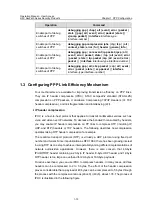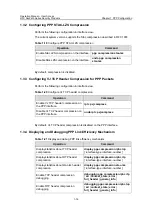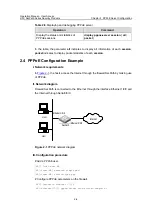
Operation Manual – User Access
H3C SecPath Series Security Products
Chapter 2 PPPoE Server Configuration
2-1
Chapter 2 PPPoE Server Configuration
2.1 Introduction to PPPoE
Point-to-Point Protocol over Ethernet (PPPoE) establishes a network comprising a
large number of hosts by making use of the Ethernet, and makes the hosts access the
Internet through a remote access device while performing access control and
accounting on each host. Due to its attractive performance-to-price ratio, PPPoE is
widely adopted in applications like community network constructions.
PPPoE is divided into two distinct phases, that is, Discovery phase and PPP Session
phase. Specifically:
When a host wants to start a PPPoE process, it must first identify the MAC address of
the Ethernet on the access end and create the SESSION ID of PPPoE. This is the very
purpose of the Discovery phase.
After entering the Session phase of PPPoE, the system can encapsulate the PPP
packet as the payload of PPPoE frame into an Ethernet frame and then send the
Ethernet frame to the peer. In the frame, the SESSION ID must be the one determined
at the Discovery phase, MAC address must be the address of the peer, and the PPP
packet section begins with the Protocol ID. In the Session phase, either the host or the
server may send PADT packets in order to notify the other to end this Session.
For more information about PPPoE, refer to RFC2516.
2.2 PPPoE Server Configuration
PPPoE server configurations include:
Fundamental configuration task of PPPoE server includes:
z
Create a virtual template and configure the related parameters
z
Enable/disable PPPoE server
Advanced configuration task of PPPoE includes:
z
Configure other PPPoE server parameters
2.2.1 Creating a Virtual Template
I. Creating a virtual template
Perform the following configuration in system view.





































